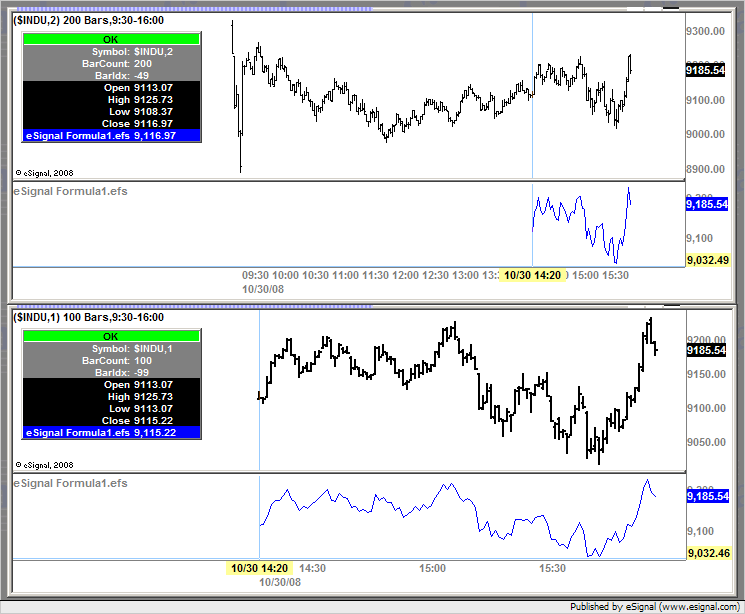EFS2 allows us to call values of some data series in external intervals, WITHOUT having to declare those data series [as we have to do with studies].
For example, we can use
var Myvar1 = open(-1,inv(XX));
anywhere, anytime, in any base interval.
I have the following questions:
1. Is EFS2 engine "compiling" these specific values as we request them, or it generates the entire data series when first encounters that call?
I am particularly interested when XX is an interval smaller than the chart interval.
2. If the entire data series is created, and XX is an interval smaller than base [chart] interval, for how many bars?
3. Are there any "default" data series for external intervals that EFS engine generates for a symbol, regardless of the base interval?
If yes, for which intervals and what data series?
4. Assuming that same data series and/or study [with exact same parameters, in diferent panes] is invoked/used, is EFS engine duplicating the study/data series for each pane?
5. We know that "reloadefs()" preserves global vars. Studies are also global vars [must be declared as such].
If reloadefs() is used to load and show diferent configuration [diferent studies, plots], what hapens with previous studies [if I do not reset them in purpose on reload efs]?
I am asking all these questions for two reasons:
a/ I want to minimize the EFS engine overhead and
b/ Apprently, lower time interval data series create abnormally high overhead, compared with all others.
I tried several ways to detect the "1S" boundary and keep running into all sorts of problems and troubles.
Thank you
For example, we can use
var Myvar1 = open(-1,inv(XX));
anywhere, anytime, in any base interval.
I have the following questions:
1. Is EFS2 engine "compiling" these specific values as we request them, or it generates the entire data series when first encounters that call?
I am particularly interested when XX is an interval smaller than the chart interval.
2. If the entire data series is created, and XX is an interval smaller than base [chart] interval, for how many bars?
3. Are there any "default" data series for external intervals that EFS engine generates for a symbol, regardless of the base interval?
If yes, for which intervals and what data series?
4. Assuming that same data series and/or study [with exact same parameters, in diferent panes] is invoked/used, is EFS engine duplicating the study/data series for each pane?
5. We know that "reloadefs()" preserves global vars. Studies are also global vars [must be declared as such].
If reloadefs() is used to load and show diferent configuration [diferent studies, plots], what hapens with previous studies [if I do not reset them in purpose on reload efs]?
I am asking all these questions for two reasons:
a/ I want to minimize the EFS engine overhead and
b/ Apprently, lower time interval data series create abnormally high overhead, compared with all others.
I tried several ways to detect the "1S" boundary and keep running into all sorts of problems and troubles.
Thank you

Comment